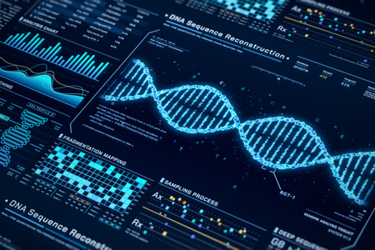Protecting Intellectual Property In The Genomics Revolution
By Jeffrey D. Morton, Haynes and Boone, LLP

We are in the midst of a revolution in the field of genomics. Twenty-plus years on from the so-called “completion” of the Human Genome Project in 2003, we are now witnessing significant advances in genomics that will have long-lasting implications in myriad disciplines, including medicine, agriculture, and biotechnology. Scientific progress has moved from a predominant focus on discrete linear nucleotide sequences to an appreciation of the beautiful complexity of the implications of these sequences such as: three-dimensional protein structures and the importance of protein-protein folding; the role of post-translation modifications such as glycosylation; and the previously undervalued importance of non-coding nucleotide sequences, such as introns.
In medicine, advances in personalized medicine, pharmacogenomics, and CRISPR-Cas9 gene editing are now moving from theory to practice. In agriculture, genomics is playing a central role in advances in sustainable agriculture, such as the development of crops that are pest and disease resistant. In the biotechnology industry, genomics is increasingly merging with artificial intelligence (AI) to foster innovations such as next-generation sequencing and improvements in related data analysis, fostered by AI advancements.
This article will look at the role that various forms of intellectual property (IP) protection have played and will continue to play in protecting key innovations in genomics.
Patents
Traditionally, utility patents have been the go-to IP tool for protecting life sciences-related innovations. In exchange for a full disclosure of the invention, the patent owner can — through a granted patent — obtain a monopoly that effectively excludes others from carrying out the same invention for a period of 20 years.1 In the life sciences arena, a period of exclusivity can be the difference between being a market leader and an unfunded company. While patent protection continues to be a hallmark of an IP protection strategy for genomics-related inventions, there are a number of legal issues that impact the utility of a pure patent protection strategy.
Patentable Subject Matter
The United States and other leading jurisdictions limit the scope of life sciences-related subject matter that can and cannot be patented. In the United States, the identification of key genomic sequences — for example, isolated human genes associated with breast cancer — when naturally occurring, cannot be patented.2 Further, and also relevant to recent advances in genomics, diagnostic methods that are viewed as merely describing a natural correlation between a biomarker and a disease state are considered to constitute unpatentable subject matter and are thus patent ineligible.3 The increasing role of AI in genomics-related inventions adds to subject matter issues as AI-relevant algorithms, in isolation, are also typically viewed as unpatentable subject matter.
Disclosure Requirements
The classic quid pro quo under patent law is that in exchange for a full disclosure of the invention by the inventor, the state will grant a patent monopoly for a defined period of time. The disclosure requirement is treated seriously by the United States Patent Office and relevant courts — and an inventor cannot “hide” key aspects of their invention while simultaneously applying for related patent protection.4 These disclosure issues become very challenging when there are aspects of an invention that are — by their very nature — difficult or impossible to patent. In such an instance, an inventor needs to consider whether disclosure of the full invention, which may include unpatentable subject matter, is worth the price of obtaining patent protection on other aspects of the same invention. For example, an invention centered around building a novel gene target panel on a gene chip device, which is likely patentable per se, could be commercially compromised if the efficacy of the panel requires disclosure of AI-generated algorithms that are unlikely to be patentable in isolation. A prospective patent applicant may ultimately decide that unfettered disclosure of the AI-related algorithms could be devastating for a business to the point that the patent protection strategy is scaled back or not sought at all.
Trade Secrets
A possible solution to the above-mentioned disclosure issue is to make use of a trade secret strategy. Unlike patents, trade secrets — by their very nature — require nondisclosure. Trade secrets offer the benefit of being unfettered by subject matter constraints and there is also no prescribed time limit as to how long a trade secret can be maintained. Many aspects of genomics-related inventions, such as algorithm development; statistical modeling between identified genes, their expression patterns, and associated disease states; and optimized experimental conditions, lend themselves nicely to a trade secret strategy. A central challenge, however, is that any subsequent disclosure of the trade secret can permanently destroy this form of IP protection. Unauthorized dissemination of a trade secret can come from a rogue employee or contractor; so, too, however, can it come during regulatory approval processes or corporate due diligence. Ultimately, an effective trade secret approach requires a clear understanding of: (a) what is being protected through trade secret; (b) who will have access to the complete trade secret; and (c) how the trade secret will be maintained.
Copyrights
Historically, copyright protection has been an IP tool of choice for protecting artistic expression, such as literary, artistic, or musical works. The software revolution pushed copyright protection into the realm of being a suitable IP category for protecting source code and, ultimately, the look-and-feel of software and websites. The genomics revolution, which is increasingly becoming one part biology plus one part computer science arguably lends itself — in certain circumstances — to copyright protection. Like trade secrets, copyright is not limited by subject matter constraints; rather, it requires original works of authorship that are fixed in a tangible medium of expression.5 AI-derived algorithms and associated data showing key correlations between genomic factors and disease states can, conceivably, be protected by copyright. Copyright protection exists both at common law and through registration, and the term of protection is also significantly longer than the term of a patent. A challenge with copyright, however, is that it cannot be used to protect inventive concepts; rather, it is the expression of these concepts that are protected. Thus, skillful competitors can arguably design around “copyright-protected expression” and focus on the same inventive concept with little concern of infringing the underlying copyright-protected material.
Conclusion
The ongoing revolution in genomics knows few technological boundaries. Therefore, it is not surprising that these advances do not fall neatly into discrete forms of IP protection. Providing superior IP protection for genomics-related inventions already requires — and will almost certainly require in the future — a more nuanced approach whereby certain aspects of these advances will be protected by patents, whereas other aspects will be protected through trade secrets or copyrights (or even other forms of IP protection not discussed herein, such as data protection). Of critical importance is ensuring that a cohesive and comprehensive IP protection strategy is employed so that the full scope of the technological advance is protected without compromising one form of IP protection (e.g., patent protection, which requires a fulsome disclosure) at the expense of the other (e.g., trade secret, which requires nondisclosure).
References/Notes
- In the United States, the twenty-year term runs from the date on which the non-provisional application is filed at the United States Patent Office.
- See, for e.g.: Association for Molecular Pathology v. Myriad Genetics, Inc., 569 U.S. 576 (2013).
- Mayo Collaborative Services v. Prometheus Laboratories, Inc., 566 U.S. 66 (2012).
- 35 U.S.C. 112(a) states: The specification shall contain a written description of the invention, and of the manner and process of making and using it, in such full, clear, concise, and exact terms as to enable any person skilled in the art to which it pertains, or with which it is most nearly connected, to make and use the same, and shall set forth the best mode contemplated by the inventor or joint inventor of carrying out the invention.
- 17 U.S.C. 102(a) states: Copyright protection subsists, in accordance with this title, in original works of authorship fixed in any tangible medium of expression, now known or later developed, from which they can be perceived, reproduced, or otherwise communicated, either directly or with the aid of a machine or device.
 About The Author:
About The Author:
Jeffrey D. Morton is a partner in the Orange County, Palo Alto, and San Francisco offices of Haynes and Boone, LLP.
